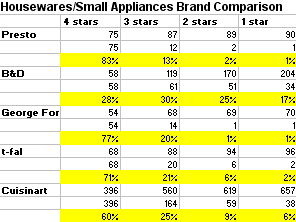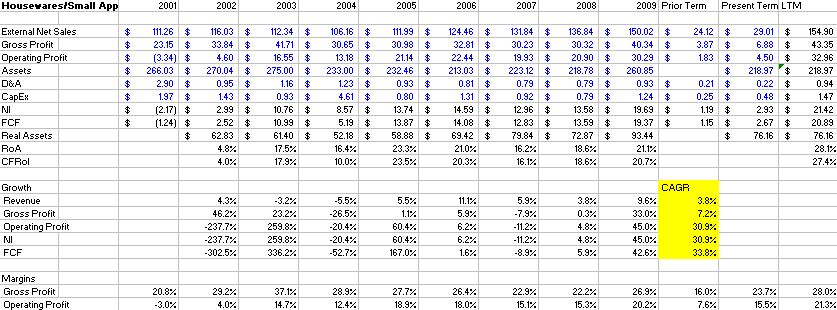Last week we introduced readers to National Presto (NPK), a business with three well diversified segments and a very healthy dividend yield in the range of 8%. This week, we’re going to dig into the housewares segment.
National Presto has a valuable brand name. In the chart below, we looked at the number of stars Presto products have earned in the Kitchen & Dining section of Amazon.com. 83% of Presto products have earned 4 stars or more, with only 1% (one product) earning one star. We compared Presto to Black & Decker, George Foreman, t-fal, and Cuisinart. The results are clear, Presto’s products are rated higher, on average, than their competitors.
We also looked within sub-segments to see if Presto products were top sellers. In all of the segments they compete in, they were. In particular, Presto has four of the top 10 best selling products in the deep-fryer category, and six of the top 10 best sellers in the pressure cooking category. It seems obvious that Presto is competitive, and arguable that the brand name might command a premium (or allow Presto to generate higher returns on invested capital).
A “sum-of-the-parts” analysis on NPK is facilitated by good financial statements. We have a breakdown of external net sales, gross profit, operating profit, total assets, depreciation, and CapEx for each segment.
While the Housewares business isn’t the largest piece of NPK, it is the core. As a result, National Presto includes cash and equivalents in the houseware segment’s “Total Assets”. By subtracting cash from this segment, we get a better sense for what sort of RoIC this segment is generating. The segment financial statements are presented below:
Looking at the numbers, the business almost appears to be stagnant with little revenue growth and somewhat steady gross margins averaging 27%. We have seen some bottom line improvement as operating margins grew. We also see that management has deliberately not been reinvesting, they’re using the FCF for something else. If management decided to grow this business, it’s difficult to imagine an RoIC of less than 15%, so I would argue that they might be missing out on a profitable reinvestment opportunity. That’s rare, most management teams will reinvest until their returns totally disappear.
As simple as this business is, we can determine an appropriate valuation for it in a number of ways. If we assume that the business continues to generate an 18% RoA (the average since 2001 has been 18.6%), we can estimate an earnings run-rate of $13.7mm off current assets of $76mm. If we demand a 15% rate of our return on our investment, we can estimate the business is worth at least 6.67x earnings, or $92mm. This is really our worst-case scenario. We’re demanding a large FCF yield on a relatively stable, unleveraged business, and we’re assuming that they had super-normal earnings selling consumer discretionary goods in a recessionary environment. We’re valuing the business at only 4.5x LTM earnings or FCF.
A more reasonable valuation might factor in continued increases in RoA or use a lower discount rate. We could also assume that if returns are as good as they appear, management might eventually start reinvesting in the business. If we assume a 50% reinvestment rate and an 18% RoA, management should be able to grow the business at 9% annually. Using LTM earnings of $21mm and a 15% discount rate, we can plug these numbers into a Gordon Growth model to get a present value of $195mm, or about 9.1x earnings.
So to conclude this section, it looks like the Housewares segment is a strong business, and we can easily justify paying 9x earnings for it. In the worst case scenario, investors should be willing to pay 4.5x current earnings.
At the time of this writing, Kerrisdale Capital and its affiliates have no position in NPK.
LEGAL:
THIS COMMUNICATION IS FOR INFORMATIONAL AND EDUCATIONAL PURPOSES ONLY AND SHALL NOT BE CONSTRUED TO CONSTITUTE INVESTMENT ADVICE. NOTHING CONTAINED HEREIN SHALL CONSTITUTE A SOLICITATION, RECOMMENDATION OR ENDORSEMENT TO BUY OR SELL ANY SECURITY OR OTHER FINANCIAL INSTRUMENT OR TO BUY ANY INTERESTS IN ANY INVESTMENT FUNDS OR OTHER ACCOUNTS. ACCOUNTS MANAGED BY KERRISDALE CAPITA, THE AUTHOR OR AFFILIATED PARTIES MAY OWN SECURITIES OF OR OTHERWISE HAVE AN INVESTMENT RELATED TO ANY COMPANIES MENTIONED IN THIS POST. WE MAY BUY OR SELL SHARES AT ANY TIME. WE MAY NOT DISCLOSE OUR PURCHASES OR SALES IF AND WHEN WE BUY OR SELL, AND WE WILL NOT NECESSARILY DISCLOSE UPDATED INFORMATION IF WE DISCOVER SOMETHING FAULTY WITH OUR ANALYSIS AT A LATER DATE.THE AUTHOR HAS NO OBLIGATION TO UPDATE THE INFORMATION CONTAINED HEREIN AND MAY MAKE INVESTMENT DECISIONS THAT ARE INCONSISTENT WITH THE VIEWS EXPRESSED IN THIS COMMUNICATION. THE AUTHOR MAKES NO REPRESENTATIONS OR WARRANTIES AS TO THE ACCURACY, COMPLETENESS OR TIMELINESS OF THE INFORMATION, TEXT, GRAPHICS OR OTHER ITEMS CONTAINED IN THIS COMMUNICATION. WE EXPRESSLY DISCLAIM ALL LIABILITY FOR ERRORS OR OMISSIONS IN, OR THE MISUSE OR MISINTERPRETATION OF, ANY INFORMATION CONTAINED IN THIS COMMUNICATION.






